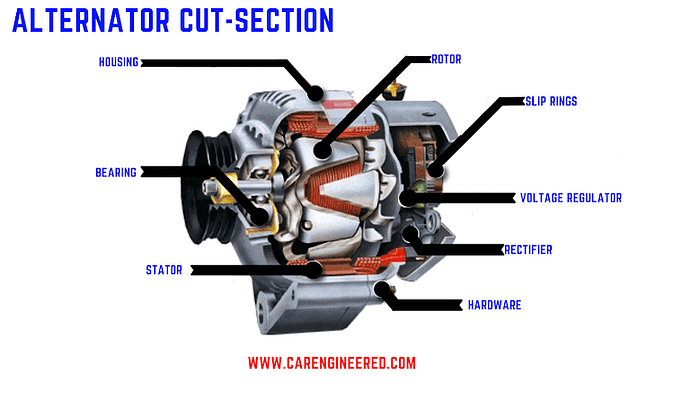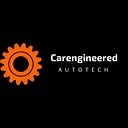The Alternators & Working
Introduction

Alternators are present in almost every automobile we see out there on the roads. Alternators are the main component in an automobile that is responsible for the charging of the battery and also to keep a constant supply of electricity to all the electrical components of the automobile. Alternators get powered from the engine itself through the timing belt that rotates the alternator through a pulley attached to the field system.
Construction
AC generators or Alternators functions on the principle of Electromagnetic Induction, just like the DC generators.
Any generator consists of 2 main things, the armature windings, and the magnetic field.
The armature windings are generally mounted on a stationary element also known as the Strator, while the other part ie the magnetic field on an element known as the Rotor.
In the DC generators, the armature coil that is attached to the stator rotates and the magnetic field remains stationary while on the other hand in AC generators the opposite happens, ie the armature coil and the stator remains at the stationary position and the magnetic field attached to the rotor rotates.
The construction is such that the alternators have 2 sides, namely the inner side and the outer side.
The outer side also called the stator consists of a cast-iron frame that forms an outer coating to the inner armature core, also having slots on its inner periphery for housing the armature conductors. from 150–600 volts.
Now when the rotor rotates, the stationary armature is reduced to 0, such that an e.m.f is produced in them.
Now as the stator has alternate poles, so the induced e.m.f also induces a current that flows in one direction and then in the other direction.
This alternating induced e.m.f is produced in the stator conductors whose frequency depends upon the number of alternating North and South windings moving past the conductor in 1 second and secondly, the direction is determined by Fleming’s Right-hand Rule.
ADVANTAGES FOR A FIXED STATOR
It is easier to transfer the load to all the electrical circuits directly from the stator terminal without contact from the rotor through the brush-contact, hence the complexity is reduced and small parts are also excluded.
Also, it is quite easy to insulate the stationary armature for quite high A.C voltages having a magnitude somewhere between 20–40 kV.
Another advantage is that the stationary stator can be more easily and effectively braced to prevent any deformation-induced from the mechanical stresses due to the centrifugal forces in action.
Components
STATOR FRAME — The stator frames are nowadays manufactured from the mild steel plates that are welded together to form a box type.
STATOR CORE — The Stator Core is supported by the stator frame that is formed from mild steel alloy plates laminated at over each other with a minute gap between every layer of these plates to allow the cold air to enter for preventing the excessive heat generations.
Also, the inner periphery of the stator core has the holes in order to hold the armature conductors.
ROTORS — There are generally 2 main types of the rotors namely
- Salient-Pole Type
- Smooth Cylindrical Type
SALIENT-POLE TYPE
- These types of rotors are generally employed with low to medium range speeds.
- They consist of a large iron rotor with a number of poles (salients) bolted.
- They have large diameters and short axial lengths.
SMOOTH CYLINDRICAL TYPE
- These types of rotors are used in steam turbine-driven alternators that run at a very high speed.
- They consist of a smooth solid forged steel cylinder with a number of slots milled at the outer periphery.
- They have small diameters and long axial lengths.
DAMPER WINDINGS
Damper windings are used to prevent the huntings (momentary speed fluctuations) in generators and are needed in synchronous motors in order to provide the starting torque.
Damper windings also tend to maintain balanced 3-Φ voltage under unbalanced load conditions.
SPEED & FREQUENCY
The relation between the speed and frequency is such that the higher the speed, the lower is the number of poles and vice-versa.
ARMATURE WINDINGS
There are mainly 2 types of armature windings mainly used for 3 phase alternators ie
- Single-layer windings
- Double-layer windings
Factors Affecting Alternators Size
The efficiency of an alternator always increases with power in its size.
Power output per kilogram increases as the alternator power increases.
As the Alternator size increases the cooling problem also increases.
Conclusion
Thus, Alternators are quite classical and sophisticated masterpieces of engineering and thus have a lot to explore that can’t be covered in a single article. But the main core functions remain to generate the electricity through changing magnetic filed, inducing the e.m.f.
